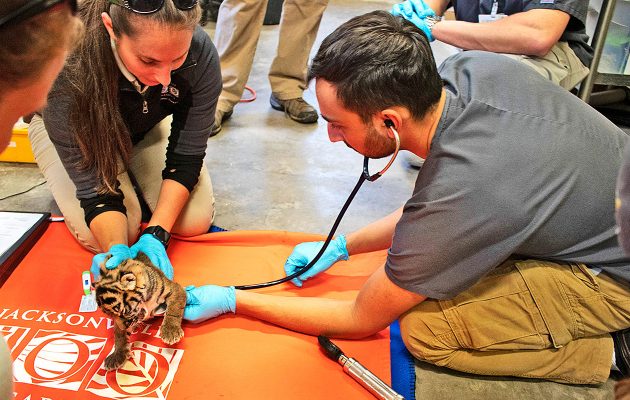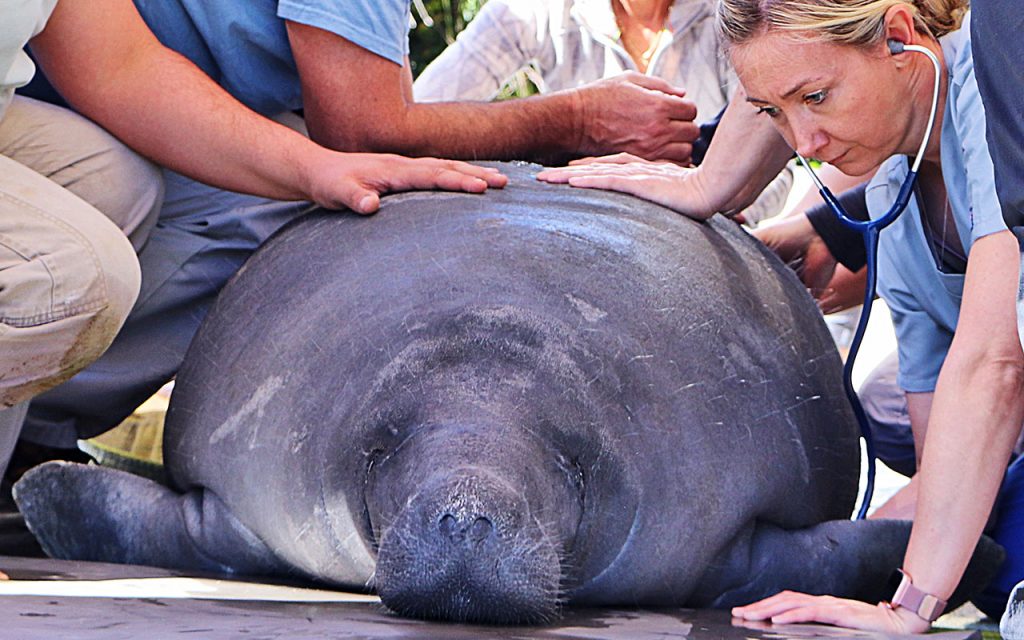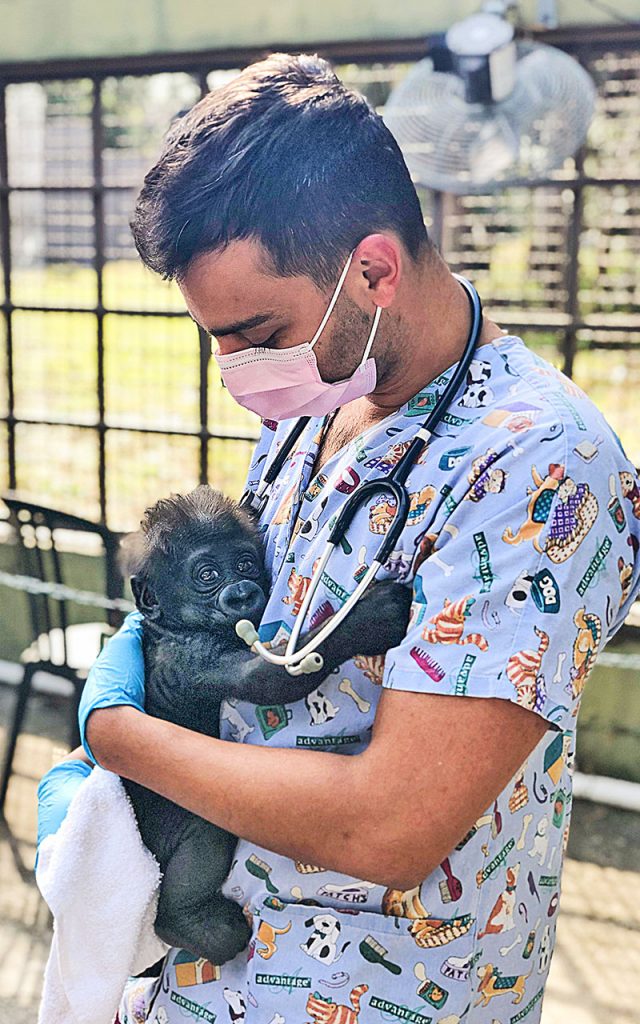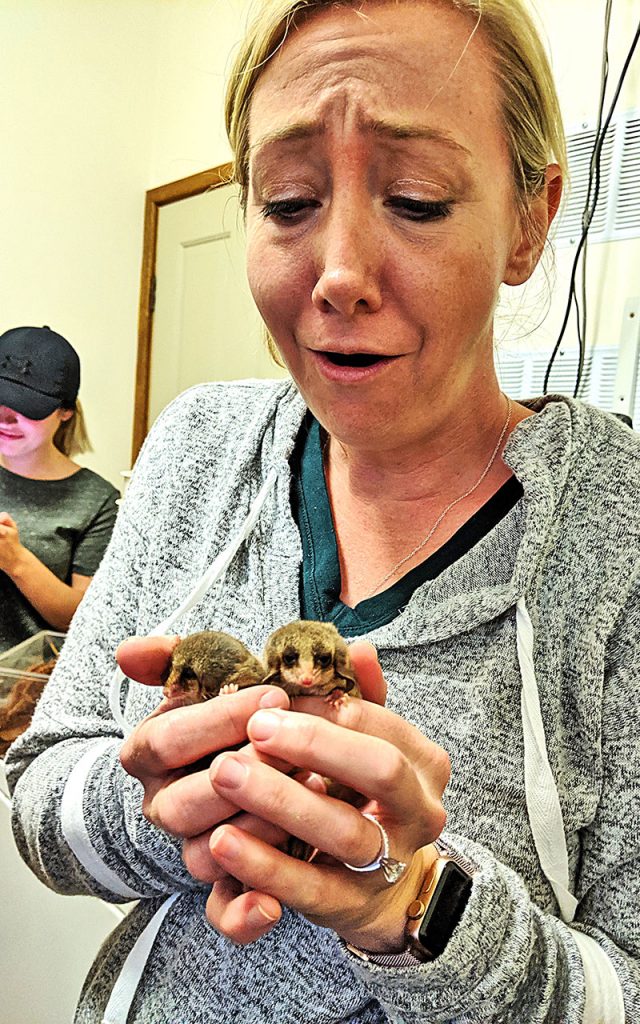Caring for world wildlife one exotic animal at a time

Jacksonville Zoo and Gardens veterinarians, Dr. Meredith Persky of San Marco, and Dr. Yousuf Jafarey of Riverside, may live 10 miles from their place of employment, but through their job they experience a little piece of nearly every corner of the world. Inside the 115-acre botanical gardens located on the Trout River, they care for rare and exotic animals from every continent except Antarctica, and both are committed to their additional roles as veterinarian representatives for the zoo’s global conservation missions to save endangered species and threatened ecosystems.

“With 2,000 animals to care for at the zoo, we know each by name and build a relationship just like a parent and child. It’s important for us to create trust and rapport,” said Persky. “The medical clinic’s daily schedule includes surgeries, preventive health care, medications, nutrition or treatment of chronic conditions, illness, injuries and emergencies. Favorite toys, foods, or treats create a positive experience during exams. While some animals require sedation, others learn to participate in or at least tolerate treatment without sedation.”
Each animal has a distinctive personality from the largest rhino to the smallest lizard. Both veterinarians enjoy getting to know and care for all of them throughout the year. Most fond of the mischievous Bonobo monkeys, Persky said that when Lorelle, an elderly Bonobo needed a procedure, there was concern.
“At age 48, Lorelle needed a procedure which is extremely risky and difficult at that advanced age. She is a testy one anyway, so for her to come through surgery and recover, it was only possible through the trust relationship we had with her,” Persky said.
Then there are the zoo residents who are all-too-frequent visitors to the veterinarian clinic, some as often as three times weekly. One particularly feisty and unfortunately fearless, little black bear named Billy, regularly lands himself into trouble.
“We see Billy all the time because he is constantly getting into something he shouldn’t. As soon as we see him, it’s ‘here we go again, what have you done now Billy!’,” Persky said. “With so many active animals on such a large property, we get a lot of limping, cuts, wounds, and swollen faces. It’s always a detective case to figure out what happened.”
Persky said she “was born to do this, because I light up just talking about it.” She moved to Jacksonville for the zoo veterinarian position in 2016. Although zoological veterinarians typically relocate often during their careers, nationally or internationally, she said she looks forward to continuing her work here.
“There are frequent after-hours emergencies. We work straight through holidays and hurricanes. Regardless of what is going on, the animals still need us,” she said. “Additional time goes to record-keeping, meetings and teaching, but I don’t even mind. Only at the zoo can the public probably ever see and closely interact with these animals, hear the lions roar, or watch the gorillas. Every ticket sold helps pay for animal care and critical zoo outreach to save endangered wildlife in Florida and elsewhere.”
Persky is married to local attorney Jay Silver who cares as much about animals as she does and understands emergency trips to the zoo at all hours. Their ACPS rescue dog, Patch, and rescue cat, Siporra, complete their family.
Meanwhile, Jafarey came to Jacksonville through Persky’s recommendation. The two animal physicians met during training and worked together while both were employed at Zoo Miami. Jafarey, who especially enjoys the reptiles, cited several difficult challenges faced by zoological veterinarians.

“It is as tough to be accepted to veterinarian school as it is to medical school. Both educational paths are expensive and require extensive post-doctoral training. Then, several years of related work experience are required to become a zoological veterinarian. Unfortunately, there are few of the necessary postgraduate positions available for zoological veterinarians each year. Usually there are only about 12 openings worldwide,” he said. “We are the ultimate veterinary generalists, who must be prepared to handle every kind of emergency medicine, including anesthesia. It is a critical responsibility to safely anesthetize anything from a tiny frog that weighs two grams, to a 10,000-pound elephant.”
Jafarey also tends to his own wildlife at home; his two pets were both hit by cars. He saved the life of his red-eared slider turtle, Ms. Pacman, and performed successful hip surgery on his rescue pitbull, Thea.
Jafarey and Persky are committed to informing and educating the public about local, regional, national, and international wildlife conservation. They are equally concerned about the closely related issues of deforestation and destruction of habitat, critical ecosystems, and plant species.
“Diverse factors impact wildlife survival, habitat and plant conservation. To protect and aid survival of threatened species, including the habitats and food sources they require, zoologists must support and coordinate efforts with local communities. They provide education, information, and ongoing support regarding conservation issues. They work to identify and develop sustainable livelihoods and food production methods to improve the standard of living for local residents. These efforts discourage poaching, illegal animal trade, deforestation, mining, wildlife and habitat destruction,” Jafarey said. “Another way we help is to support park rangers, like those in Sumatra, Indonesia, who actively patrol to prevent poaching of the critically endangered Sumatran Tigers.”
The Association of Zoos & Aquariums member organizations work cooperatively to help insure the survival of threatened and endangered wildlife species. They create and manage Species Survival Plans (SSP) of which the Jacksonville Zoo participates in 93. These comprehensive plans maintain captive populations of specific animals for genetic diversity and demographic stability in the U.S. and throughout the world – wherever wildlife faces extinction.
“We travel to a specific animal’s location to investigate why that animal population is in decline. It could be threatened by invasive species, loss of habitat, food sources or other threats. We identify the threats and find solutions to save that animal, improve its breeding, overall health and ultimate survival however possible,” Jafarey said. “An example would be local amphibian conservation efforts. There are only a few surviving populations of the aquatic striped newt salamander, once found throughout the southeastern U.S. Loss of habitat has decimated the population, but breeding, release, and monitor programs are underway.”

The Jacksonville Zoo’s extensive local, regional, and worldwide conservation programs support more than 45 global initiatives. A few include: Manatee Rescue & Rehabilitation Center at the zoo; Jacksonville Wood Stork Rookery Project at the zoo; Striped Newt Project-Apalachicola National Forest; Central American River Turtle Project – Belize; Gorilla Rehabilitation & Conservation Education Center (GRACE), near Tayna Nature Reserve, Democratic Republic of Congo (DRC); Lola ya Bonobo – Kinshasha, DRC; International Rhino Foundation Project – Sumatra, Indonesia; Okapi Conservation Project – DRC; Rupununi Wildlife Research Unit – Guyana, South America; wild orchids – Jacksonville Zoo in coordination with Atlanta Botanical Garden’s Southeastern Center for Conservation.
Persky and Jafarey both said that a portion of every zoo entrance ticket goes to fund local and global conservation. They encourage awareness of human impact on wildlife and the environment and suggest ways to conserve both.
“We share the world with these incredible animals. Unfortunately, without successful conservation efforts now, there may be a time when we cannot see a polar bear or a tiger,” Persky said. “There are many small ways to take action in our daily lives. Recycle and purchase reusable items. Avoid plastic and discard it properly, not into waterways or the environment, where it can injure or kill wildlife. Choose sustainable fish and palm oil products. The expansion of non-sustainable palm oil plantations is among the leading causes of deforestation and loss of irreplaceable forest and jungle ecosystems.”
The 33rd Annual Jacksonville Zoo SPOOKTACULAR will be held every night at the zoo from October 23 – 31st, 2020. For tickets and details go to www.jacksonvillezoo.org. Support the zoo and its conservation work through the purchase of tickets, become a member or patron, donate, volunteer and see events on their website. The zoo is located at 370 Zoo Parkway. Call (904) 757-4463 or email for more information: [email protected].
By Julie Kerns Garmendia
Resident Community News






